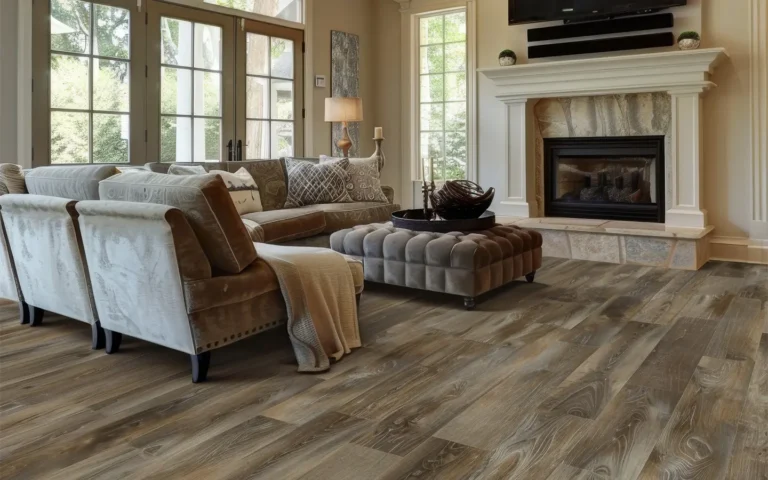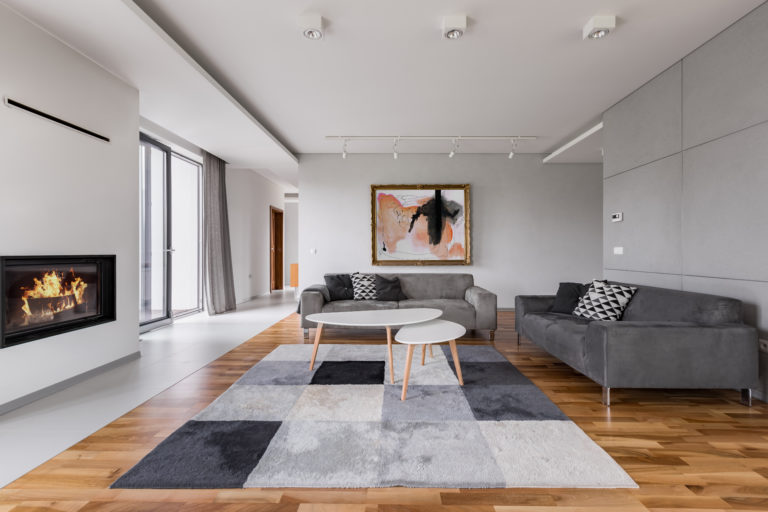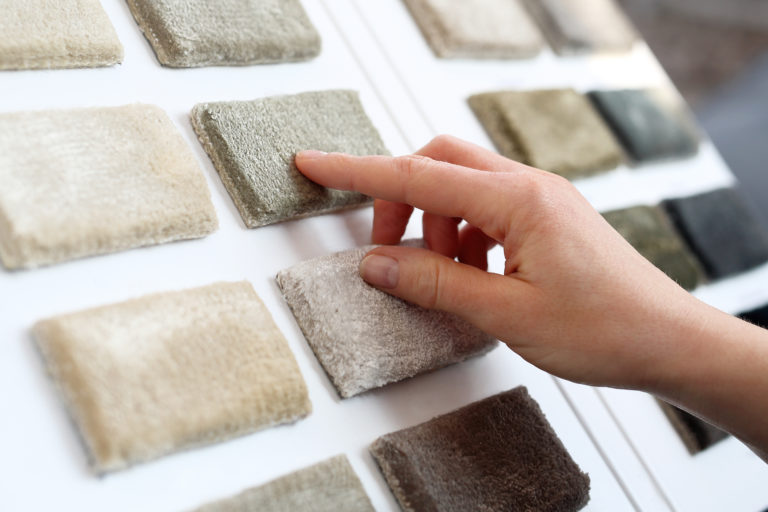You’re trying to decide on new floors, and you’ve narrowed it down to tile vs. laminate. But you’re stuck, as both are awesome types of flooring that offer excellent features. So now what?
Below, we compare the pros and cons of tile vs. laminate floors at every level. We’ll look into tile vs. laminate cost, discuss each material’s makeup, and cover resale value and durability concerns.
Then, we will talk about the pros and cons of each flooring material’s maintenance, waterproofing, underfoot feel, and appearance. We’ll even explore the pros and cons of tile vs. laminate in kitchens, bathrooms, and basements.
In short, we’re going to dive into everything you need to know about laminate vs. tile flooring because we’re here to help.
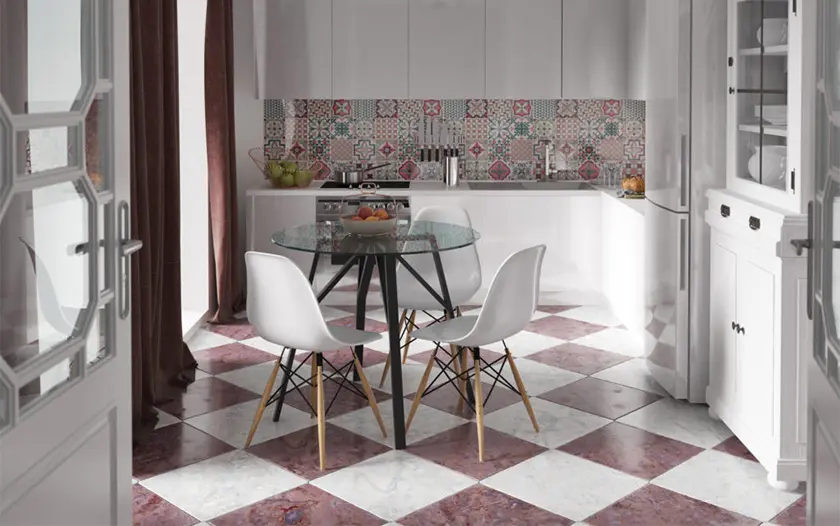
Which Flooring is More Budget-Friendly?
When it comes to choosing flooring that aligns with your budget, both tile and laminate offer competitive options but with different financial implications over time.
Tile: Tile flooring costs vary widely, with ceramic or porcelain options generally ranging from $2 to $9 per square foot. Prices can climb higher for large format or specialty tiles, sometimes up to $14 per square foot. Natural stone tiles, known for their luxury and durability, can command even higher prices. The installation of tile is a significant factor to consider, as it typically ranges from $5 to $12 per square foot, depending on the complexity of the project and the design choices made.
Laminate: Laminate flooring stands out for its affordability, with prices for the materials ranging from $2 to $7 per square foot. The cost advantage extends to installation, which is generally more economical than tile, averaging between $2 and $6 per square foot. This makes laminate an attractive option for those looking to minimize both material and labor costs in their flooring project.
Verdict: If material and installation costs are your primary concern, laminate flooring offers a clear advantage with its lower price point and more affordable installation. However, while laminate is budget-friendly initially, tile flooring can be viewed as a long-term investment.
Despite the higher initial cost, the tile’s durability and potential to increase home value may offer better financial returns over time. Therefore, the choice between tile and laminate should consider not only the immediate budget but also the long-term value and lifespan of the flooring.
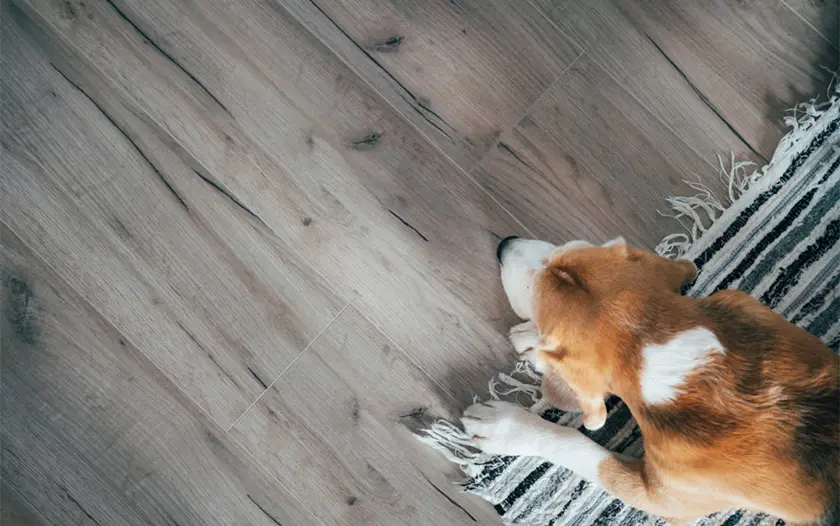
How Do They Compare in Terms of Maintenance?
The ease of maintenance for your flooring not only affects your daily routine but also impacts the longevity and appearance of your floors over time.
Tile: Tile flooring is renowned for its low maintenance requirements, making it a favorite in spaces where cleanliness and hygiene are priorities. Simple routines like mopping and occasional scrubbing are usually sufficient to keep tile floors looking pristine. Certain types, like cement tiles, may need periodic resealing to maintain their protective layer, but many ceramic and porcelain tiles are virtually maintenance-free, aside from regular cleaning.
The key to ensuring tile’s longevity lies in caring for the grout; keeping it clean and sealed can make your tile floors last indefinitely. However, in the event of damage, tile offers a straightforward repair process; individual tiles can be replaced without needing to disturb the entire floor.
Laminate: Laminate flooring brings the beauty of hardwood with significantly less upkeep. It doesn’t require resealing or specialized treatments, making it a hassle-free option for busy households. The caveat with laminate, however, is its sensitivity to moisture. Wet mopping or using the wrong cleaners can damage the wear layer or cause the planks to warp, so it’s crucial to follow the manufacturer’s care instructions closely.
While laminate is undoubtedly convenient to install, its repair process can be more cumbersome than tile. Damaged laminate planks often necessitate dismantling the floor up to the affected area due to their interlocking design.
Verdict: While both tile and laminate boast ease of maintenance, tile edges ahead slightly due to its superior repairability and durability in the face of spills and moisture. Laminate, with its straightforward cleaning regimen and no need for resealing, is exceptionally user-friendly, especially for those seeking minimal upkeep.
However, when it comes to repairs, tile’s modular nature allows for easier fixes without the need for extensive floor replacement. Ultimately, the choice between tile vs laminate may come down to prioritizing ease of everyday care versus simplicity in handling repairs.
Best Brands of 2024
Which Flooring Has Better Longevity?
The longevity of your flooring is a testament to its durability and ability to withstand the rigors of daily life, from foot traffic to pet antics.
Tile: Tile’s reputation for durability is well-earned, with many installations lasting upwards of 50 years or more. Its resilience to heavy foot traffic, pets, and even enthusiastic tap dancing sessions makes it a stalwart choice for any area of the house. The waterproof nature of properly grouted tile adds to its longevity, making it impervious to most household accidents.
The primary concern with tile is its susceptibility to chipping or cracking upon impact with heavy objects, but even then, the repair process is straightforward—simply replace the damaged tile, and it’s as good as new.
Laminate: Laminate flooring boasts a tough wear layer that guards against scratches and dents, making it a robust option for homes bustling with kids and pets. On average, laminate floors can serve your home well for 10 to 25 years, depending on the quality of the product and the intensity of use.
However, laminate’s Achilles’ heel is its vulnerability to moisture. Spills need to be promptly cleaned to prevent warping and swelling, and heavy items can cause denting, which compromises the floor’s appearance and integrity over time.
Verdict: When it comes to longevity, tile takes the lead with its unparalleled durability and ease of repair. Tile’s ability to withstand a wide range of challenges, from moisture to heavy use, without showing signs of wear makes it a long-lasting investment for your home. Laminate offers commendable durability and is resistant to scratches and dents, but its sensitivity to moisture and potential for denting under heavy weight makes it slightly less robust in comparison. For homes that demand the utmost in durability and longevity, tile is the unrivaled champion.
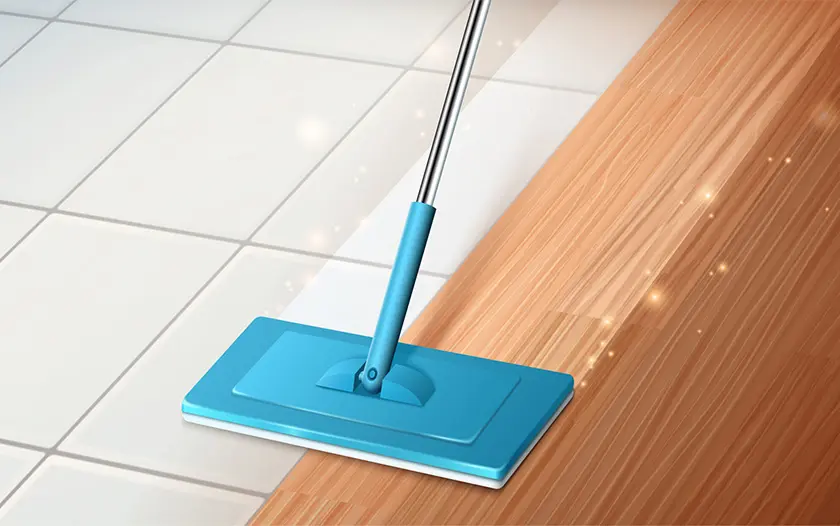
Which Floor Provides More Comfort?
Comfort is a subjective aspect of flooring that varies based on personal preferences and the specific needs of your living space.
Tile: Tile flooring is known for its ability to stay cool, which can be a significant advantage in warmer climates. Its capacity to absorb heat makes it an ideal choice for areas exposed to sunlight, providing a naturally cool surface underfoot. However, tile’s hardness and chilliness in cooler environments might not be everyone’s cup of tea. The good news is, comfort with tile can be easily enhanced with the addition of area rugs or peel-and-stick carpet tiles, offering a cozy touch for sensitive feet.
Laminate: Laminate flooring, while sometimes criticized for feeling slightly artificial or plasticky, especially in lower-priced options, offers a different kind of comfort. Its installation over an underlayment allows for a bit of flexibility underfoot, creating a softer feel compared to the rigidness of tile. This “floating” installation can make laminate more forgiving and comfortable for extended standing or walking, which could be a plus in living areas or kitchens.
Verdict: Comfort with flooring largely boils down to individual preferences and the specific conditions of your home. If you prefer a floor that remains cool to the touch and doesn’t mind a firmer surface, tile might be your go-to. On the other hand, if you’re looking for a floor with a bit more give and warmth, laminate could be the better choice. Ultimately, the decision between tile and laminate for comfort should consider your climate, the room’s use, and your personal comfort criteria.
Which One is Healthier?
When it comes to the health aspects of flooring choices, it’s essential to consider the impact on indoor air quality, allergen accumulation, and overall living environment.
Tile: Tile flooring shines in the health department, largely due to its hard, non-porous surface that leaves little room for dust mites, mold, and other allergens to hide. It’s an excellent choice for those with allergies or respiratory issues, as it can be easily swept and mopped clean of any irritants. Moreover, high-quality tile options typically emit low levels of volatile organic compounds (VOCs), making them a safe bet for maintaining pristine indoor air quality.
Laminate: Laminate flooring, with its layered construction, also presents a relatively low risk for allergen accumulation, particularly if well-maintained and cleaned regularly. However, some laminate products may off-gas higher levels of VOCs compared to tile, especially shortly after installation. Opting for laminate products certified for low VOC emissions can mitigate this concern, ensuring a healthier living space.
Verdict: In the quest for the healthiest flooring option, tile slightly edges out laminate due to its superior allergen resistance and typically lower VOC emissions. Tile’s ease of cleaning and maintenance further bolsters its standing as a top choice for a health-conscious home. However, with mindful selection and proper care, laminate can also provide a healthy and safe environment, making it a viable option for those prioritizing low allergen levels and indoor air quality.
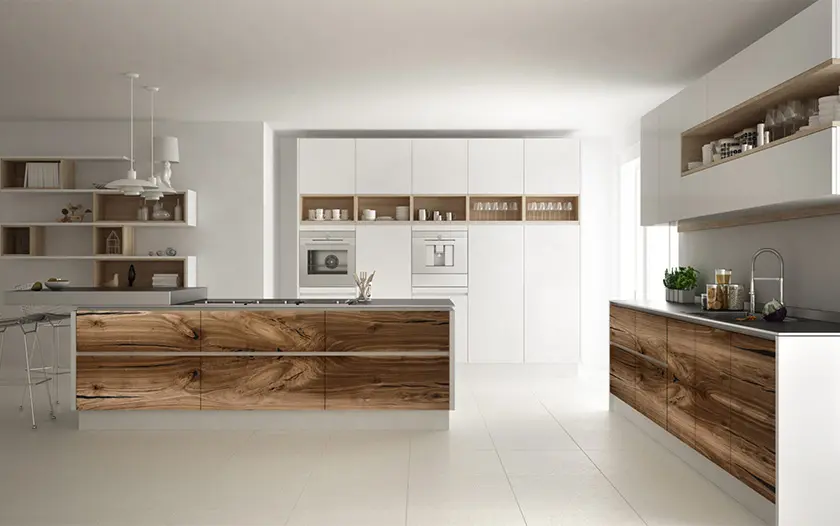
Deciding Between Tile vs. Laminate in Specific Rooms
Choosing the right flooring for each room in your house involves weighing the unique challenges and needs of each space. Let’s explore how tile and laminate measure up in kitchens, bedrooms, bathrooms, and basements.
Kitchens: The kitchen is the heart of the home but also a hotspot for spills and moisture. While laminate flooring can handle the occasional splash and some brands offer waterproof options, it’s not inherently waterproof like tile. The risk with laminate is water seeping into the edges and beneath the flooring, potentially causing damage. Tile, with its complete water resistance, stands out as a robust option for kitchens. However, it’s essential to choose tiles with a high Coefficient of Friction (CoF) to prevent slips, especially in such a high-traffic area.
Bathrooms: In bathrooms, where water is a constant, the choice leans even more towards tile for its waterproof qualities. Laminate can be used, especially if opting for brands that provide fully waterproof products, but careful consideration is needed to ensure the flooring will withstand the bathroom’s wet conditions. Tile not only offers water resistance but also opens up a range of design possibilities suitable for bathroom aesthetics.
Basements: When it comes to basements, the choice between laminate and tile is less about the flooring surface and more about the right underlayment to protect against moisture and temperature changes. Both laminate and tile can be suitable for basements, provided they’re installed over an underlayment designed to handle the basement’s unique environmental conditions.
Bedrooms: When it comes to choosing flooring for bedrooms, comfort and ambiance take precedence. Laminate flooring, with its warmth and variety of designs that mimic natural wood, can add a cozy and inviting feel to any bedroom. It’s also relatively soft underfoot, especially when compared to tile, making it a comfortable choice for spaces where you often walk barefoot.
On the other hand, tile might be preferred in bedrooms in warmer climates for its cool touch, but it generally lacks the cozy warmth many desire in a bedroom setting. Additionally, the acoustics of tile might not be as favorable in a bedroom, as it can make the space feel less intimate and more echoey.
Verdict: Tile’s unparalleled water resistance makes it a go-to choice for wet areas like kitchens and bathrooms, offering durability and peace of mind. In kitchens, if opting for laminate, choose a waterproof option and be mindful of water exposure. For bathrooms, tile is generally preferred for its moisture-handling capabilities, though waterproof laminate can be a viable alternative.
In basements, the focus should be on selecting an appropriate underlayment to ensure the longevity of whichever flooring type you choose. Remember, the right flooring choice balances the room’s functional needs with your personal style and maintenance preferences.
Tile vs. Laminate… Who Wins?
In the comparison between tile and laminate, it’s clear that there’s no outright winner. The best choice really depends on your specific needs and preferences.
If you’re in need of a durable flooring option that can handle moisture and spills with ease, tile is a great choice. It’s perfect for areas in your home that see a lot of water, like bathrooms and kitchens. While it might be a bit more expensive and require some extra care, its longevity and resilience in wet conditions are unmatched.
On the other hand, laminate offers a practical and stylish flooring solution that won’t break the bank. It’s ideal for those who want the look of wood without the high cost or maintenance. Laminate is easy to install and care for, making it a popular choice for many homeowners.
Ultimately, whether you choose the durability of tile or the convenience and style of laminate, you’re making a solid choice for your home. Both options have their own unique benefits that can suit different lifestyles and preferences.
About The Author

Daniel Meeks
February 1, 2024
Daniel Meeks is a flooring expert with over 10 years of experience in the industry. Holding a BS in Marketing from Emerson College, Daniel has spent his professional career writing for some of the biggest names in interior design. In his spare time, Daniel enjoys hiking, baking, and hanging out with his dog, Artie.

